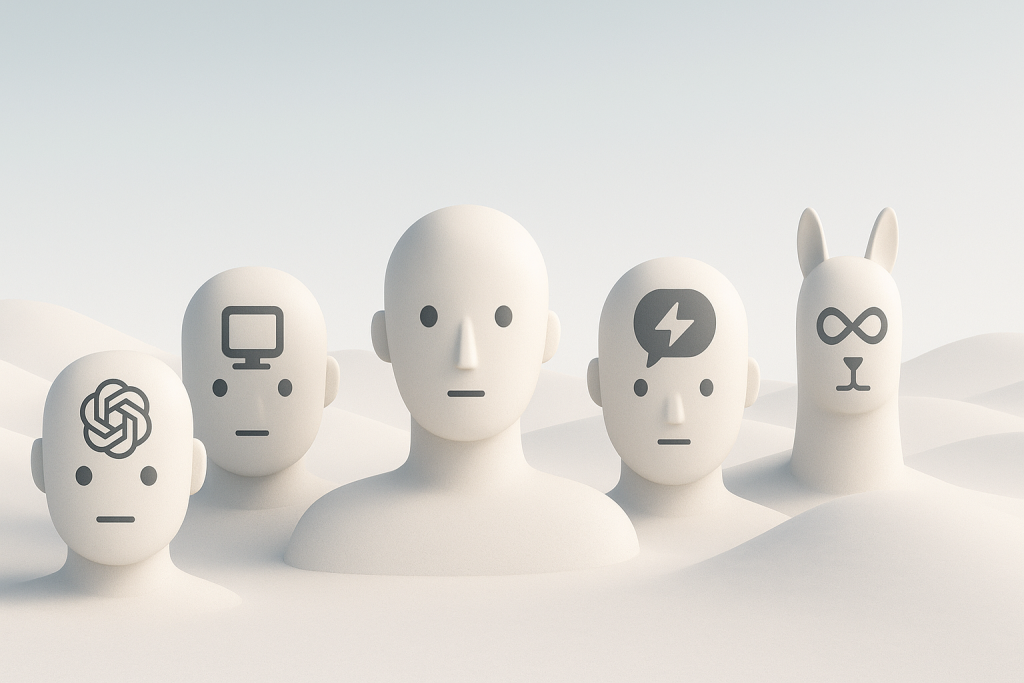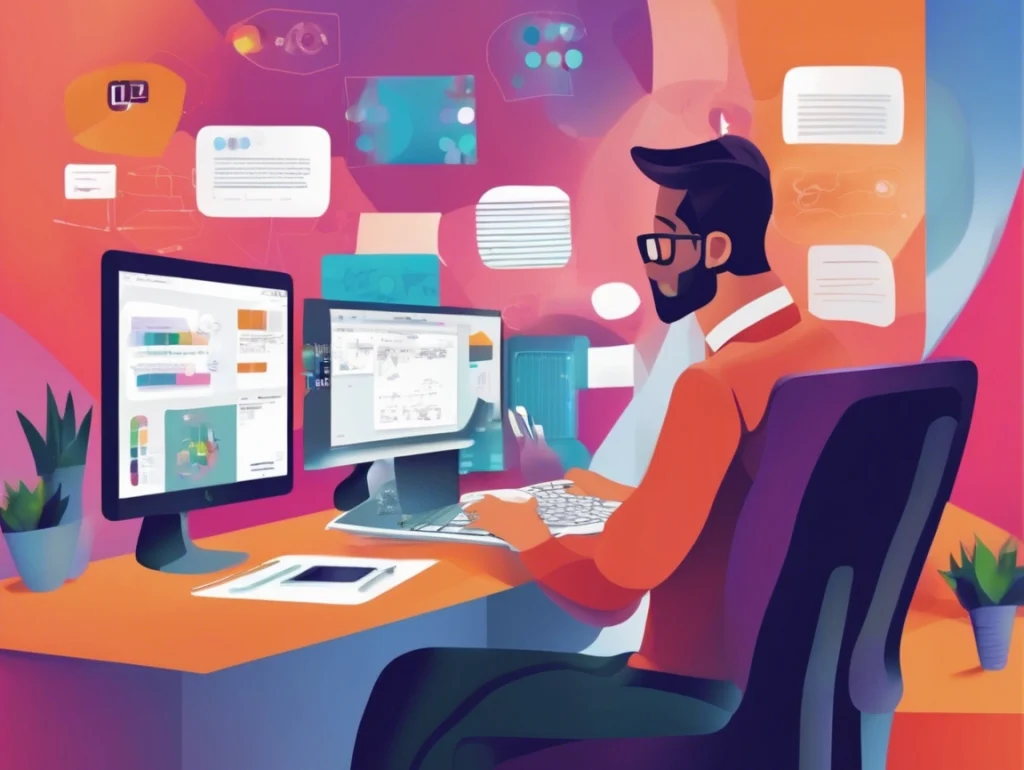How HR Leaders Are Using Generative AI Today (And How You Can Start Safely)

Last week, a Melbourne HR director told me she’d accidentally automated herself out of 10 hours of weekly admin work using ChatGPT. Her reaction? Pure panic. Not because she feared for her job, but because she had no idea what to do with all that extra time — or whether she’d just violated every data privacy law in the country.
Sound familiar? You’re not alone.
Right now, 38% of Australian workers are using generative AI at work, up from virtually zero two years ago. But here’s the kicker: while marketing teams are racing ahead (34% adoption), only 12% of HR departments have properly integrated these tools. That’s not just a gap — it’s a chasm that’s widening every day.
The irony? HR should be leading this charge, not trailing behind. After all, we’re the ones who understand people, processes, and the delicate dance between innovation and compliance. Yet most HR professionals I meet are stuck in analysis paralysis, watching from the sidelines as other departments transform their workflows.
Today, that changes. I’m going to show you exactly how forward-thinking HR teams are using generative AI right now — with real examples from companies you know. More importantly, I’ll show you how to start safely, stay compliant, and actually enjoy the journey.
No tech degree required. No jargon. Just practical guidance from someone who’s helped hundreds of non-technical professionals harness AI without losing their minds (or their data).
What is Generative AI — And Why HR Should Care
Let’s start with the basics, because I’ve noticed even seasoned professionals get this wrong. Generative AI isn’t just another automation tool — it’s fundamentally different from the AI systems you might already use.
Traditional AI analyses data and makes predictions. Think of your ATS that screens CVs or workforce analytics that predict turnover. These systems look at patterns and tell you what’s likely to happen. Useful? Absolutely. Creative? Not really.
Generative AI, on the other hand, creates new content. It writes, designs, codes, and problem-solves by learning from massive datasets and understanding context. When you ask ChatGPT to draft a job description or Microsoft Copilot to summarise meeting notes, it’s not pulling from a template library — it’s generating something new based on patterns it’s learned.
Think of it this way: traditional AI is like a brilliant analyst who spots trends in your data. Generative AI is like having a talented intern who can draft, create, and iterate — except this intern works 24/7, never gets tired, and improves with every interaction.
Now, before you roll your eyes and mutter “here we go, another tech evangelist,” let me address the elephant in the room: the misconceptions that keep HR teams stuck.
Misconception 1: “It’s only for tech teams”
Rubbish. The Australian Public Service just ran a trial with 7,600 employees across 60+ agencies. These weren’t developers — they were policy officers, administrators, and yes, HR professionals. Result? They saved an average of one hour per day. That’s five hours a week of reclaimed time.
Misconception 2: “It’s too risky for HR data”
Valid concern, terrible conclusion. Yes, 89% of Australian workers worry about data misuse in AI systems. But that’s exactly why HR needs to lead — to establish safe, compliant practices before cowboys in other departments create a mess we have to clean up.
Misconception 3: “AI will replace HR professionals”
This one makes me laugh. AI can’t conduct a sensitive redundancy conversation, mediate workplace conflict, or build genuine connections with employees. What it can do is handle the mundane tasks that drain your energy and time.
As I often tell my clients: Gen AI doesn’t replace HR — it helps people be more human in their work. When you’re not drowning in admin, you can focus on what matters: strategy, culture, and actually helping your people thrive.
The real question isn’t whether to use generative AI in HR. It’s how to use it wisely, ethically, and in ways that amplify your uniquely human capabilities rather than diminish them.
5 Ways Generative AI Is Already Improving HR Processes
Enough theory. Let’s look at what’s actually working in the real world. These aren’t pie-in-the-sky concepts — they’re practical applications that HR teams are using today, with measurable results.
1. Recruitment: From Job Ads to Candidate Matching
Remember spending hours crafting the perfect job ad, only to realise you’ve unconsciously used language that excludes certain groups? Generative AI is changing that game entirely.
Take Seek’s new AI-powered tools, for instance. They’re not just checking for gendered language anymore — they’re actively rewriting job descriptions to appeal to diverse candidate pools while maintaining your company’s voice. One construction firm in Melbourne used these tools to rewrite their project manager job ads and saw a 47% increase in female applicants within three months.
But it goes beyond writing. AI-powered screening tools can now:
- Parse thousands of CVs in minutes, not hours
- Match candidates to roles based on skills, not just keywords
- Generate personalised interview questions based on each candidate’s background
- Draft rejection emails that are actually helpful (yes, really)
The key? Human oversight. AI suggests, humans decide. That’s the model that works.
2. Onboarding: Personalised Journeys at Scale
Here’s a dirty secret: most onboarding programmes are one-size-fits-none disasters. New hires sit through generic presentations, fill out the same forms, and wonder why they left their last job.
Generative AI flips this script. Imagine onboarding that adapts to each person’s role, experience level, and learning style. AI chatbots can now:
- Answer new starter questions 24/7 (goodbye, “urgent” emails at 9pm)
- Generate role-specific training content on demand
- Create personalised welcome messages from team members
- Track progress and flag when someone might be struggling
A Sydney fintech startup implemented this approach and cut their time-to-productivity for new developers from 8 weeks to 5. Their secret? An AI assistant that generated custom coding challenges based on their actual codebase, not generic tutorials.
3. Learning & Development: Content That Actually Sticks
Traditional L&D often feels like drinking from a firehose — too much content, not enough relevance. Generative AI changes the equation by creating learning content that matches individual needs.
Picture this: your performance management system identifies that Sarah needs to improve her presentation skills. Instead of enrolling her in a generic three-day course, AI:
- Analyses her current skill level through work samples
- Generates bite-sized learning modules targeting her specific gaps
- Creates practice scenarios based on real presentations she’ll give
- Provides feedback in real-time as she practises
This isn’t fantasy — it’s happening now. Companies using AI-powered learning platforms report 40% higher completion rates and 60% better skill retention compared to traditional e-learning.
4. Performance Management: Beyond Annual Reviews
Annual performance reviews are like dental check-ups — necessary but nobody enjoys them. Generative AI is helping transform this dreaded ritual into ongoing, meaningful conversations.
Here’s how progressive companies are using AI in performance management:
- Continuous feedback loops that analyse communication patterns and flag when someone might be struggling
- AI-generated discussion guides for managers based on team dynamics and individual goals
- Automated progress tracking that writes itself (no more scrambling to remember what happened six months ago)
- Bias detection in performance reviews — AI can flag when language patterns suggest unconscious bias
5. Employee Experience: The Telstra Success Story
Now for my favourite example: Telstra’s My Career platform. While launched in 2018 (making it ancient in AI terms), it remains one of Australia’s best examples of AI-powered internal mobility done right.
The platform uses AI to match employees’ skills with internal opportunities — think of it as Tinder for career development, but less awkward. Results?
- 50% adoption rate (16,000+ employees actively using it)
- 400 employees retained who would have otherwise left
- $18 million saved in recruitment and training costs
The genius wasn’t just the technology — it was understanding that employees want growth, not just stability. By making internal moves as easy as external job hunting, Telstra kept talent that competitors were trying to poach.
The lesson? Generative AI works best when it solves real human problems, not just technical ones.
Real-World Results: Case Studies from Australia and Beyond
Numbers don’t lie, and the data from early adopters is compelling. Let’s examine how organisations are turning AI experiments into measurable business outcomes.
The Australian Public Service: Democracy Meets AI
When you think “innovation,” the public service probably isn’t your first thought. Yet their 2024 Microsoft Copilot trial might be the most comprehensive generative AI study we’ve seen in Australia.
The numbers are staggering:
- 7,600 participants across 60+ agencies
- Average time saved: 1 hour per day per user
- 77% user satisfaction rate
- 86% wanted to continue using the tool
But here’s where it gets interesting. The trial revealed both the promise and the pitfalls of AI in large organisations. While productivity soared, concerns emerged about AI’s impact on junior and female employees who often handle administrative tasks that AI could automate.
One senior policy officer told researchers: “Copilot helped me draft cabinet submissions in half the time, but I worry about graduates who won’t learn by doing anymore.”
The trial also uncovered bias issues when AI generated content about First Nations communities, highlighting the critical need for human oversight and cultural sensitivity checks.
ANZ Bank: Speed Meets Scale
While the public service tested broadly, ANZ went deep with developers. Their 2024 deployment of GitHub Copilot to 3,000 developers and Microsoft 365 Copilot to another 3,000 employees shows what happens when you combine the right tool with the right users.
Key outcomes:
- 40% faster task completion for developers
- 50% reduction in time spent on boilerplate code
- 30% fewer bugs in initial code reviews
- Developers reported higher job satisfaction (less grunt work, more creative problem-solving)
But ANZ didn’t just throw technology at the problem. They invested heavily in training, created internal communities of practice, and — crucially — measured everything. Their approach offers a blueprint for other organisations: start with a specific use case, measure obsessively, and scale what works.
The Hidden Success Stories
Not every AI success makes headlines. Some of the best examples come from companies quietly transforming their operations:
A Melbourne manufacturing firm used generative AI to rewrite all their safety procedures in plain English. Result? 35% reduction in workplace incidents and 50% better compliance test scores.
A Brisbane healthcare provider deployed AI chatbots to handle routine employee queries. Their HR team now spends 60% less time on admin and 100% more time on strategic initiatives.
A Perth mining company uses AI to generate personalised mental health check-ins for FIFO workers. Early intervention rates increased by 40%, potentially saving lives.
The Global Context: Australia’s Position
Here’s the sobering reality: Australia lags behind in AI adoption. Deloitte’s 2024 research shows:
- 38% of Australian employees use Gen AI at work (up from 20% in 2023)
- But we’re second-lowest in Asia-Pacific (regional average: 67%)
- Singapore leads at 80% adoption
- Even the US (often seen as slower to adopt) sits at 45%
John O’Mahony from Deloitte put it bluntly: “Australia has a ‘she’ll be right’ approach to Gen AI adoption. That attitude risks us falling behind in the global talent race.”
The good news? Australian organisations that do adopt AI report higher satisfaction rates and better outcomes than global averages. We might be slow starters, but we’re thorough implementers.
Risks, Legal Pitfalls and How to Stay Compliant
Now for the part that keeps HR directors awake at night: compliance. And rightfully so. Get this wrong, and you’re not just facing fines — you’re risking your organisation’s reputation and your employees’ trust.
The Privacy Minefield
The Office of the Australian Information Commissioner (OAIC) isn’t mucking around. Their 2024 guidance on AI and privacy makes several things crystal clear:
You must conduct privacy impact assessments before implementing any AI system that handles personal information. No exceptions. This isn’t a box-ticking exercise — it’s a detailed analysis of how data flows through your AI systems and where vulnerabilities exist.
De-identification isn’t optional. If you’re using employee data to train AI models, you need robust de-identification processes. And here’s the catch: true de-identification is harder than most people think. Simply removing names isn’t enough when AI can infer identity from patterns.
Human review is mandatory for significant decisions. You cannot — repeat, cannot — let AI make final decisions about hiring, firing, or promoting without human oversight. The Australian Public Service Merit Protection Commissioner made this abundantly clear after their Copilot trial.
The Bias Problem
Here’s an uncomfortable truth: AI systems learn from historical data, and our history isn’t exactly bias-free. When Amazon’s AI recruitment tool started penalising CVs that included the word “women’s” (as in “women’s chess club captain”), it wasn’t being deliberately sexist — it was pattern-matching based on historically male-dominated tech roles.
Australian organisations face similar risks. Common bias traps include:
- Training AI on historical performance data that reflects past discrimination
- Using language models that don’t understand Australian cultural contexts
- Deploying tools tested on US or European populations without local validation
The solution isn’t to avoid AI — it’s to be ruthlessly vigilant about bias detection and correction. Regular audits, diverse testing groups, and continuous monitoring are non-negotiables.
The Copyright Conundrum
Here’s a question that’ll make your legal team squirm: who owns the content that AI generates? If Copilot writes a brilliant policy document, can your competitor copy it? If ChatGPT helps draft an employment contract, are you infringing on someone else’s IP?
The legal landscape is murky, but some principles are emerging:
- AI-generated content isn’t automatically copyrighted (machines can’t hold copyright)
- But AI might reproduce copyrighted material it was trained on
- Your safest bet: always review and modify AI output before using it officially
Employee Concerns: The Numbers Don’t Lie
Deloitte’s 2024 research reveals what’s keeping employees up at night:
- 89% worry about misuse of sensitive data
- 87% fear AI will produce factual errors
- 84% concerned about legal and copyright risks
- 76% worry their jobs will be automated away
These aren’t irrational fears — they’re legitimate concerns that HR must address head-on. Transparency isn’t just nice to have; it’s essential for maintaining trust.
Your Compliance Checklist
Based on OAIC guidance and best practices from early adopters, here’s your minimum viable compliance framework:
- Establish clear AI usage policies that specify what tools can be used, for what purposes, and with what data
- Conduct privacy impact assessments before deploying any AI tool that touches personal information
- Implement human-in-the-loop processes for all significant decisions
- Create audit trails showing how AI recommendations influenced decisions
- Train employees on responsible AI use (not just how to use it, but when not to)
- Regular bias audits with documented remediation plans
- Incident response procedures for when (not if) something goes wrong
Remember: the goal isn’t perfect compliance (impossible with evolving regulations) but demonstrable good faith effort and continuous improvement.
Where Most HR Teams Get Stuck (And How to Get Unstuck)
Let’s address the elephant in the room: why is HR so far behind other departments in AI adoption? The statistics are damning — only 12% of HR teams actively use generative AI compared to 34% in marketing and 41% in IT.
But before you feel too bad, understand that this isn’t about HR being technophobic or resistant to change. The barriers are real, systemic, and surprisingly fixable once you know what you’re dealing with.
Barrier 1: The Confidence Gap
Most HR professionals I meet aren’t afraid of AI — they’re afraid of looking stupid. They worry about asking “dumb” questions or making costly mistakes with unfamiliar technology.
Here’s the thing: everyone’s faking it to some degree. That marketing manager who seems so confident with ChatGPT? They probably spent their first week generating terrible content and accidentally sharing internal data. The difference? They kept experimenting.
The fix: Start small and private. Use AI for low-stakes personal tasks first:
- Draft your own emails
- Summarise meeting notes just for yourself
- Create presentation outlines for internal use
Build confidence before you tackle high-stakes HR processes.
Barrier 2: The ROI Mystery
CFOs love hard numbers. HR traditionally deals in soft metrics. When AI vendors promise “transformation,” finance wants to know exactly what that means in dollar terms.
The APS trial gives us solid benchmarks:
- 1 hour saved per day = 12.5% productivity gain
- For a $100k employee, that’s $12,500 in annual value
- Multiply by your team size for rough ROI
But don’t ignore soft benefits:
- Reduced burnout from automating repetitive tasks
- Improved employee experience from faster query resolution
- Better decision-making from data-driven insights
Document everything. Track time saved, errors reduced, and satisfaction improved. Build your business case with data, not promises.
Barrier 3: The Policy Vacuum
Many organisations operate in a policy grey zone — AI isn’t explicitly forbidden, but it’s not officially sanctioned either. This creates a worst-case scenario where employees use AI secretly, without guidance or guardrails.
GetApp’s research found that 67% of Australian workers use generative AI weekly, but only 31% have clear policies governing its use. That gap is a ticking time bomb.
The fix: Create a minimum viable policy now, not a perfect policy later. Cover the basics:
- Approved tools and use cases
- Data handling requirements
- Human oversight mandates
- Incident reporting procedures
Update quarterly as you learn. Perfect policies are the enemy of good protection.
Barrier 4: The “Wait and See” Trap
John O’Mahony from Deloitte nailed it: Australia’s “she’ll be right” attitude is our biggest weakness. While we’re waiting for perfect solutions, competitors are learning from imperfect experiments.
Consider this: 39% of Australia’s workforce is in professional roles that AI could significantly disrupt. That’s not a future threat — it’s happening now. Every month you wait is a month of learning lost.
The Myth-Busting Reality Check
Let’s demolish the three myths that keep HR teams paralysed:
Myth 1: “AI will replace HR professionals”
Reality: AI handles tasks, not relationships. It can screen 1,000 CVs but can’t read the room during a delicate redundancy conversation. It can draft policies but can’t build culture. AI amplifies human capabilities; it doesn’t replace human judgment.
Myth 2: “AI is too unreliable for HR work”
Reality: Humans make errors too — we just call them “judgment calls.” AI’s errors are more visible and correctable. With proper oversight and testing, AI often produces more consistent results than humans, especially for routine tasks.
Myth 3: “AI is too expensive for our budget”
Reality: Basic tools like ChatGPT Plus cost less than a coffee per day. Microsoft Copilot comes bundled with many enterprise licenses. The real cost isn’t the technology — it’s the opportunity cost of falling behind.
Learning from Leaders
AHRI and QUT’s research reveals what separates AI leaders from laggards:
- Leaders experiment constantly (fail fast, learn faster)
- Leaders measure everything (time saved, errors reduced, satisfaction improved)
- Leaders share learnings openly (creating internal communities of practice)
- Leaders start before they’re ready (70% confidence is enough)
The pattern is clear: action beats analysis paralysis every time.
From Curiosity to Capability: Your Next Steps in Generative AI
Enough theory and case studies. You’re convinced (or at least curious), and you want to start. But where? The options feel overwhelming, the risks seem high, and you’ve got actual work to do today.
Here’s your practical, no-nonsense roadmap to getting started with generative AI in the next 30 days.
Week 1-2: Pick Your Starter Projects
Don’t try to transform everything at once. Choose one or two low-risk, high-impact use cases from this starter menu:
1. Job Description Refresh
- Tool: ChatGPT or Claude
- Task: Rewrite your three most-used job descriptions for clarity and inclusion
- Time investment: 2 hours
- Potential impact: Better quality candidates, more diverse applicant pool
2. Interview Question Bank
- Tool: Any generative AI
- Task: Generate behavioural interview questions for your five key roles
- Time investment: 1 hour
- Potential impact: More consistent, skills-focused interviews
3. Policy Simplification
- Tool: Microsoft Copilot or ChatGPT
- Task: Rewrite one complex policy in plain English
- Time investment: 3 hours
- Potential impact: Better compliance through understanding
4. Onboarding Email Series
- Tool: Any generative AI with email capability
- Task: Create a 5-email welcome series for new starters
- Time investment: 2 hours
- Potential impact: Consistent, warm onboarding experience
5. Meeting Minutes Magic
- Tool: Copilot, Otter.ai, or similar
- Task: Auto-generate and refine meeting summaries
- Time investment: 30 minutes to set up
- Potential impact: 5+ hours saved weekly
6. Employee FAQ Bot
- Tool: ChatGPT or Microsoft Bot Framework
- Task: Create responses for your 20 most common employee questions
- Time investment: 4 hours
- Potential impact: 50% reduction in routine queries
Week 3-4: Build Your Tech Stack
You don’t need every AI tool on the market. Start with this practical toolkit:
For Microsoft Shops:
- Microsoft 365 Copilot (integrates with Word, Excel, Teams)
- Power Automate for workflow automation
- Azure OpenAI for custom solutions
For Google Workspaces:
- Gemini (formerly Bard) for workspace integration
- AppSheet for no-code AI apps
- Vertex AI for advanced users
Platform-Agnostic Options:
- ChatGPT Plus or Claude Pro for general tasks
- Notion AI for knowledge management
- Seek’s AI tools for recruitment
- Canva Magic Write for visual content
Budget-Conscious Starter Pack:
- ChatGPT free tier (good enough for experimentation)
- Microsoft Copilot (if you have M365)
- Google Gemini (free with workspace)
The Non-Negotiable: Human-in-the-Loop
Whatever tools you choose, build human oversight into every process from day one. This isn’t optional — it’s essential for compliance, quality, and trust.
Your human-in-the-loop checklist:
- Review all AI output before it becomes official
- Verify facts and figures (AI confidently states nonsense sometimes)
- Check for bias, especially in anything touching recruitment or performance
- Ensure Australian context (most AI trains on US data)
- Add your organisation’s voice and values
Measuring Success: What Good Looks Like
After 30 days, you should see:
- Time savings: At least 5 hours per week across your team
- Quality improvements: Fewer errors in routine documents
- Consistency gains: Standardised processes that still feel human
- Confidence growth: Team members actively suggesting new use cases
Red flags that indicate you’re moving too fast:
- Employees feel threatened rather than empowered
- Quality drops in the name of speed
- Compliance concerns arise
- The human touch disappears from employee interactions
Your 90-Day Milestone
By three months in, aim for:
- 3-5 processes augmented with AI
- Clear ROI data on at least one initiative
- Basic AI literacy across your HR team
- A living AI policy that’s been tested in practice
- At least one “wow” moment that converts sceptics
The Learning Never Stops
The AI landscape changes weekly. Tools that don’t exist today will be essential tomorrow. That’s overwhelming, but it’s also liberating — nobody expects you to know everything.
Stay current without drowning:
- Follow one or two trusted AI educators (shameless plug: our Dumb Monkey AI Academy newsletter breaks down what matters for business leaders)
- Join HR-specific AI communities (AHRI has growing resources)
- Set aside 30 minutes weekly for AI experimentation
- Share learnings with peers (teaching reinforces learning)
The Mindset Shift
Here’s the most important change: stop thinking of AI as a technology project and start seeing it as a capability upgrade. You didn’t learn Excel overnight, and you won’t master AI instantly either. But just as spreadsheets transformed HR in the ’90s, AI will transform it in the 2020s.
The question isn’t whether to start — it’s whether to lead or follow. And if you’ve read this far, I’m betting you’re not the following type.
Your Journey Starts Now
We’ve covered a lot of ground — from the APS’s groundbreaking trial to Telstra’s retention success, from compliance nightmares to practical starter projects. But knowledge without action is just sophisticated procrastination.
The HR leaders who’ll thrive in the next decade aren’t necessarily the most technical or the earliest adopters. They’re the ones who start before they feel ready, learn from every experiment, and never forget that HR is fundamentally about humans.
Yes, generative AI will change how we work. It already is. But it won’t change why we work — to create organisations where people can do their best work, grow their careers, and maybe even enjoy the journey.
Your employees are already using AI, whether you know it or not. Your competitors are experimenting, whether you’re ready or not. The future is arriving at 38% adoption and climbing.
The only question left is simple: Will you help shape that future, or watch it happen?
Start small. Start safe. But for heaven’s sake, start.
After all, that Melbourne HR director who accidentally saved 10 hours a week? She’s now leading her company’s AI transformation. Her secret wasn’t technical brilliance — it was the courage to try, the wisdom to learn, and the humility to ask for help when needed.
Sounds a lot like good HR to me.





Responses